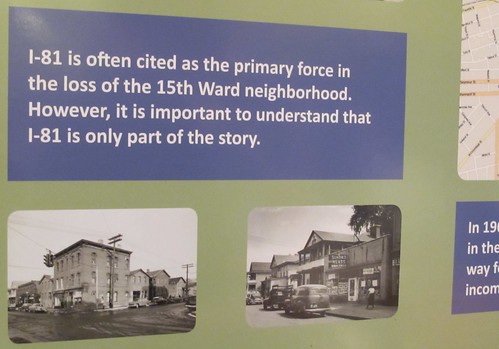Probably inspired by three parallel verses in the Bible (Matthew 12:25, Mark 3:24-25 and Luke 11:17), the English political philosopher Thomas Hobbes wrote back in 1651, “A kingdom divided in itself cannot stand.”
In the South Side community of Pioneer Homes, the question is whether a neighborhood divided cannot stand. It has been partitioned for 47 years out of its 74 years of existence. It’s still standing, but this might change soon, at least for its buildings that are immediately adjacent to the Interstate 81 expressway.
Pioneer Homes, the first federally funded housing project in New York State, was constructed between 1938 and 1940. In 1967 the project had its first date with the wrecking ball when five of its buildings, containing 44 apartments, were torn down, along with other parts of the 15th Ward, and were replaced with an elevated section of the I-81 highway, a section made up of 19 bridge spans, supported by 36 bridge piers.

This massive section of concrete and steel, which runs on the South Side between East Adams and Van Buren streets, was later on designated by the Federal Highway Administration (FHWA) as “functionally obsolete.” Among its “significant deficiencies,” its “non-standard design features” include lane widths of 12 feet each, shoulder widths of 4-5 feet each and a median width of 8 feet. Since the I-81 viaduct is expected to reach the end of its useful life in 2017, a replacement alternative will need to make the lanes, shoulders and median wider.
This possibility has Bill Simmons worried. He is the executive director of Syracuse Housing Authority, which owns Pioneer Homes. He said that a broadening of I-81 on the South Side might lead to a “relocation of tenants.”
A physical survey indicated that, in the worst case scenario, 10 buildings with 98 apartments could be scheduled to have the second date of Pioneer Homes with the wrecking ball. It’s estimated that at least 250 individuals reside in these buildings, which comprise two-story row houses with family units and three-story walk-ups with one-bedroom units.
The Interstate 81 viaduct project director for the New York State Department of Transportation, Mark Frechette, said on April 2 that his department is seeking to “ramp up engagement with the community to get its input” on the fate of the viaduct. He added that so far NYSDOT has received close to 4,000 comments about the elevated portion. He expects to hear more from the community in June, when a scoping meeting is slated in order to record the public’s sentiments in this regard.
Frechette spoke at the Carrier Theater in the John Mulroy Civic Center, 411 Montgomery St., to introduce the first installment of the Interstate 81 Speaker Series, which is sponsored by Onondaga County Executive Joanie Mahoney, Syracuse Mayor Stephanie Miner and NYSDOT Commissioner Joan McDonald.
The maiden speech in the series was delivered by Virginia Greiman, a former Director of Risk Management for the Central Artery (Interstate 93)/Tunnel Project in Boston, unofficially known as the Big Dig. The speech drew from Greiman’s findings, which are detailed in her book “Megaproject Management: Lessons on Risk and Project Management from the Big Dig.”
Greiman described the I-93 viaduct, knocked down by the Big Dig project, as “an ugly green monster and an eyesore, which was built in the ’50s because its developers didn’t have the technology to build a tunnel instead.”
“The viaduct area was dark,” she said. “As a result of the construction of the Big Dig project, now you see in parks, fountains, people walking through this area. This is sustainability.”
Sustainability was one of the three recurring themes that punctuated Greiman’s talk, along with risk management, and accountability. She said that a project’s success consists in achieving sustainability, not in being on time and budget, or meeting goals.
“It’s not just the traditional iron triangle of scope, cost and time,” she added. “Sustainability was expressed with the Big Dig by it allowing the building of new housing, beautification and the reduction of fear in the former viaduct area.”
She listed other sustainable benefits of the Big Dig: reknitting of neighborhoods formerly separated; improvement of ventilation and air quality; implementation of a smart highway system; enhancement of economic opportunities with the development of a trained work force and minority- and women-owned businesses, and; creation of open space.
She concluded this part of her presentation by saying that sustainability encompasses economic, social and institutional benefits. “Projects should focus on sustainability, not only green but institutional,” she said. “The sustainable solution could be completed later and be more expensive than the non-sustainable ones.”
Greiman told the audience that the Big Dig project strove to “operate a world-class risk management control” but this was made difficult by the nature of megaprojects, some of whose characteristics are: long duration (5-40 years); ambiguity and uncertainty; large scale policy-making and quality of life issues; complex organizational and governance structures and systems, and; consistent cost underestimation.
She added: “Competency in decision-making requires adequate assessment of risk, uncertainty and complexity, and sensitivity to context. It’s hard to forecast what would happen in 10 years and what would need change. There is also technology innovation in this period. It’s a moving target, a roller coaster with ups and downs. That is why it’s normal for many megaprojects to be over their budgets.”
She went on to say that megaprojects require “open systems” due to their complex interrelationships with the communities and the citizens it serves. She understood an open system as one in which the local communities are the biggest stakeholders and one that is characterized by full transparency.
“The change inherent in megaprojects is best managed through integration and collaboration,” she said. “Its management should be based on extensive public scrutiny and giving back to the community. Partnering and stakeholder participation are crucial.”
The idiom “the squeaky wheel gets the grease” appeared to be in full effect during the time of the Big Dig project. Greiman said, “As project managers, we had to take people into account, even noisy stakeholders who screamed at us and threatened us demanding changes in the project.”
LIST OF PIONEER HOMES BUILDINGS IMMEDIATELY ADJACENT TO THE I-81 VIADUCT
A – West of the viaduct
1) Building 31 (2 stories) 101-103-105-107-109-111-113-115-117-119 (10 apartments) Tyler Court
2) Building 34 (3 stories) 121 A-B-C-D-E-F (6 apartments) Tyler Court
123 A-B-C-D-E-F-G-H-I-J-K-L (12 apartments) Tyler Court
3) Building 39 (3 stories) 132 A-B-C-D-E-F (6 apartments) Stewart Court
134 A-B-C-D-E-F-G-H-I-J-K-L (12 apartments) Stewart Court
4) Building 42 (2 stories) 116-118-120-122-124-126-128-130 (8 apartments) Stewart Court
5) Building 47 (2 stories) 100-102-104-106-108-110-112-114 (8 apartments) Stewart Court
Subtotal West side: 5 buildings with 62 apartments (DEMOLITION MIDDLE RANGE CASE SCENARIO)
B – East of the viaduct
2) Building 57 (2 stories) 117-119-121-123-125-127-129-131 (8 apartments) Light Court
3) Building 59 (3 stories) 101 A-B-C-D-E-F (6 apartments) Dyer Court
4) Building 60 (3 stories) 100 A-B-C-D-E-F (6 apartments) Dyer Court
5) Building 64 (2 stories) 101-103-105-107-109-111-113-115 (8 apartments) Gage Court
Subtotal East side: 5 buildings with 36 apartments (DEMOLITION BEST CASE SCENARIO)
Total both sides: 10 buildings with 98 apartments (DEMOLITION WORST CASE SCENARIO)
– Article by Miguel Balbuena, Community Correspondent for The Stand; Homepage Cover Photo by Tony Shi
 The Stand
The Stand


